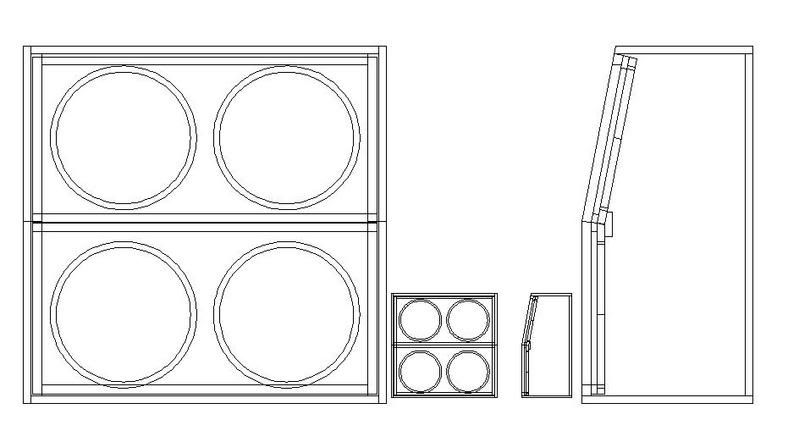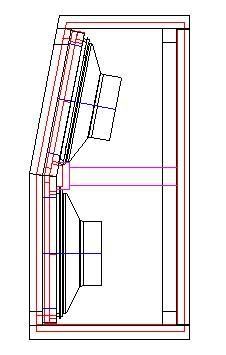|
|
Post by RJB on Sept 30, 2007 0:01:41 GMT -5
I'm going to be doing some low power (1/2 - 2W) custom amp experiments. But I've got a set of 4, 3.5" speakers from a project at work, and I thought a 1/4 scale 4x12 cab would be fun. Looking for WxD, floor footprint. D for the top. Overall height, height to slant, and speaker dimensions. C to C and heights for each pair.
I looked at most of the manufacturers and none give anything other than overall.
|
|
|
|
Post by sumgai on Sept 30, 2007 12:04:58 GMT -5
RJB, One thing I can tell you is, paper cones don't scale!  By that I mean, you can't simply reduce all dimensions a like amount, and expect the same kind of sound (full, or whatever you liked about the bigger box). To that end, there are lots of theories about how to build a cabinet for any size speaker, singly or in multiples. I hate to say it, but I've gotta suggest that you google for "speaker cabinet design" and pick a few pages to get you started. It's a deep topic, but when you're done, you'll have a much better sounding box than just any old thing that someone told you to build "20 cubits by 40 cubits" and so forth. In general, 3½" speakers are not known for producing a very full, or well-rounded, sound. Lacking the physical dimension to move some serious air for the lower frequencies, you may want to investigate various non-standard cabinet designs. Any folded horn will give you better bass response. One of my favorites is the Symmetrical Air Friction Enclosure. There are lots of others. (Isobaric chambers, anyone?  ) HTH sumgai |
|
|
|
Post by RJB on Sept 30, 2007 12:36:53 GMT -5
SG
Thanks for the advice, this is only one of many ideas. The reason for the question was for a purely visual aesthetic. I'm actually already doing some research along those lines. I was considering some tuned port designs, was also looking into passive diaphragm, and phase opposed front and rear facing pairs. Would you happen to know of any good design resources online?
These 3.5" speakers were chosen by an audio engineer (no longer w/Co.) 12yrs ago for extremely heavy magnets and fairly full range sound. Not even sure I can get the datasheets anymore. I'm also going to be using a Peavey 8" Blue Marvel in a Rage 158, and some generic 12" in a Kuston Lead I (early 80's SS beast).
Basically looking to experiment with different speakers for a Pignose 7-100 as well as some ideas based off the "runoffgroove" website.
I'll be sharing some stuff in the future.
Ron
|
|
|
|
Post by JohnH on Sept 30, 2007 16:03:25 GMT -5
Ron - If you pm your email, I can send you a file with construction dimensions for a Marshall 1960 4x12 slant cab.
Thats a closed back cab. Marshall get away with various much smaller cabs, which are still acceptable to the buying public. Theres the MG microstacks, with two 1x10 cabs, and the smallest MG of all, the MG10 (which I have) uses a 1x6.5"driver and sounds fine for a small amp.
Heres my guess at how to do this: ratio the dimensions by say 3.5/12, except for the front to back depth which I reckon would work much better with more depth than that to keep volume up and may work with Sumgais suggestions.
The other thing that Marshall does with these small boxes is include a cab-simulation circuit, which boosts the low end and cuts the highs, before the power amp.
good luck
John
|
|
|
|
Post by RJB on Sept 30, 2007 17:37:50 GMT -5
Thanks JohnH, PM sent
Actually was thinking along the line of those MGs. Kind of a little half-stack.
The amp ideas are using FETs to replace tubes from a Princeton and/or a Deluxe. Right down to a output transformer which would be near it's limits when the FETs saturate. Still looking for the right tranny though. I'll probably start with a little 1/4watter I have on my bench already. Might just run the output into a load, a speaker sim, and then into a super clean/linear Class 'D' power amp and a flat response speaker. Kind of like the Valvetronix.
|
|
|
|
Post by JohnH on Sept 30, 2007 17:48:30 GMT -5
That could be a great project. Ive built a few stompboxes with a string of overdriven JFETs - and they provide great saturated crunch. I find 2n5457 is the best balance of properties for this on a 9V supply. I havent tried introducing a tranny into them yet though. The overdrive sounds I can get from this are much better than the diode-based ones on the Mg, and I actually prefer them to the valve OD on my DSL combo - for AC/DC 'Malcolm' crunch. - so i feed this into a clean amp.
John
|
|
|
|
Post by ChrisK on Sept 30, 2007 22:53:26 GMT -5
Yes! I'd built Isobaric D'Appolito configs back when I thought that I could still hear.
You know, the whole "Speaker Builder" and "Glass Audio" stuff back in the early 90's.
"Audio Concepts" anyone (they're long out of business but had great woofers - 16 Hz.).
I remember the "Sweet 16" concept of the 60's/70's. Put 16 6" x 9" speakers on a common baffle and get great response. I even remember an article where this design was installed in the rear opening of a full-size delivery van. Man, talk about a moving baffle.
In the end, this sounded just like 16 6" x 9" speakers, no better, but certainly no worse.
Physics is.
|
|
|
|
Post by sumgai on Oct 1, 2007 0:40:02 GMT -5
Chris, I built one of those, I think it was in 1964. The Popular Electronics article was in 1963, and it took me several months to save up enough money to buy the speakers! Remember the follow up article some time later, the one that showed the same scheme, only instead of all the same size speaker, they used an alternate staggered array of 4x6, 5x7 and 6x9 speakers? I built one of those for my uncle, and he liked it too. Good sound for the investment dollar, but that probably wouldn't be true today. But I have to admit, I never saw the van, that must have been the forerunner of all the little rice-burning kilowatters now polluting the soundscape.  Audio Concepts??? The primo speakers of their day, to be sure. But Oh Lowerd, you had to rob a bank to pay for those suckers!  sumgai |
|
|
|
Post by RJB on Nov 20, 2007 12:45:08 GMT -5
Hi all. Revisiting an old post with an update. First order of business. A complete oversight on my part is that I forgot to thank JohnH for the PDF file of cabinet dimensions. It took 2 tries w/ 4 different email addresses but it got here 1/2 way around the world. From that I used my CAD program to make a fairly detailed model. which I then scaled down by 35/120 (program didn't like decimels in scale factor)  This resulted in a scaled down cab that was the right size for the speakers I have. Down side is 3/16" (~5mm) wall thickness. Might as well use heavy cardboard. So I bumped out the wall thicknesses to 3/8" while keeping the inside volume the same. I could have used the 1" MDF scraps from my son's custom subwoofer box for his car, but I didn't want a 12" cube to way 25lbs. I happen to have have some 3/8" solid oak laying around, so I'll use that. I also simplified the baffle design just because I'm lazy.  Over the next couple of weeks I'm hoping to get this built, and get a n external speaker jack installed on the Pignose. I'm assuming a bit of a 'boxy' sound so I'll also try some open back configurations as well. btw opening the Pignose during use, improves the sound quailty as well. RJB |
|
|
|
Post by JohnH on Nov 20, 2007 20:57:54 GMT -5
Thats going to be a cool little cab. I'm imagining that a smallish port at the back might be the best enhancement to the sound, rather than full open or closed. I have no justification for that view except that it might reduce the tight boxiness of the cab, while maximising the signal path from negative phased sound coming from the back, interacting with positive signals from the front. Dunno, but I do think it is well worth doing some rough tests with rear baffle configs, prior to do the final finishing. Also, I reckon Id add a couple of extra out-of-scale inches to the depth.
In this case, my opinion is based on gut feeling with no experience, so Im interested in others views and how it works out
cheers
John
|
|
|
|
Post by ChrisK on Nov 20, 2007 23:19:31 GMT -5
If you want to do the small port thing (tuned port), use a length of plastic pipe perhaps 1" +/- a little in diameter. Push the pipe almost all of the way into the cabinet (with maybe a 3/4" gap to the front baffle board. Slide the tube out to effect tuning. When it sounds best, cut off the part of the tube that extends out of the box. That's how ya tune a bass reflex cabinet. An acoustic suspension is tuned by design and stuffing. A passive radiator is tuned by design and adding mass to the, uh, passive radiator. Good luck, although I think that you'll have trouble finding those 1/2" high valves. ;D "Acorns" anyone? (If you know what I mean, you'll know what I mean. If you don't, you won't.)  |
|